Paddle board yoga offers a great workout, improves balance, and gets you outdoors to reduce stress. However, it can be tough to know where to start, particularly if you’ve never practiced a yoga routine on the water.
I’m going to show you some paddle board yoga poses perfect for beginners. So grab your board, and get ready for some mindful exercise.
RELATED: Read our yoga paddle board reviews to find out which yoga SUP to get in 2024.
1. Easy Seat Yoga Pose – Sukhasana
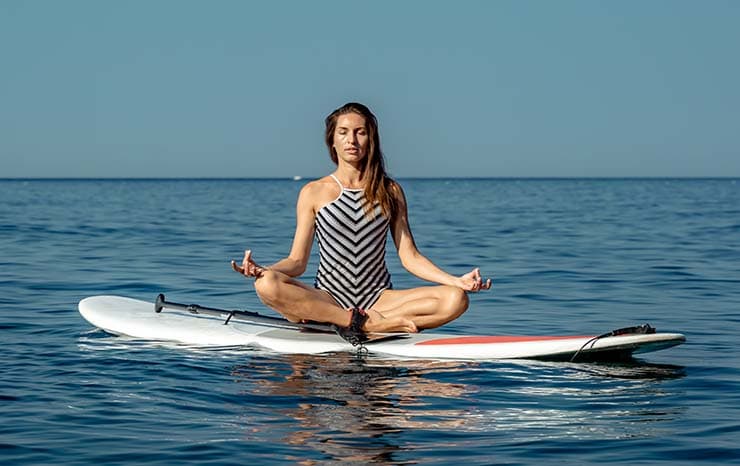
Easy seat is where anyone can begin SUP yoga. By sitting and focusing on the board’s movement, you can start your journey with ease.
You can sit sideways if you’re purely out to relax, but if you’re ready for some yoga flows then start facing the front of the board. Sit with your back straight and tall and cross your legs in front of you. Place your hands on your knees.
Take deep breaths, close your eyes, and open your senses. Feel the board and focus on how it moves on the water. Listen to the sounds and notice what you can smell. Bring your hands up to your heart center and sit and breathe in a seated prayer position.
2. Tabletop Yoga Pose – Bharmanasana
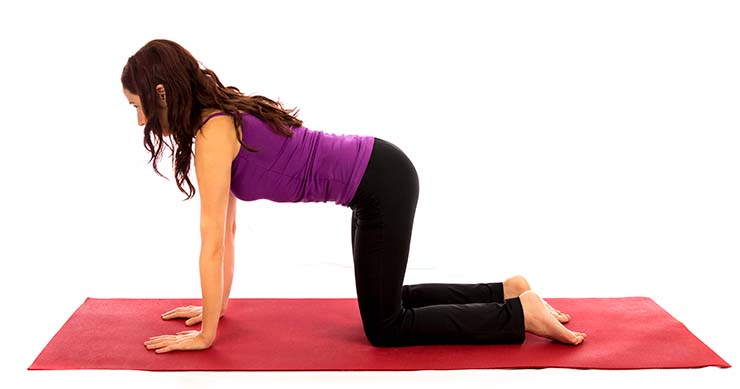
Move to a tabletop pose from your seated position by leaning forwards and placing your hands on the board in front of you. One at a time, bring your knees onto the deck pad, placing them hip distance apart. Next, shuffle backward and adjust your knees slightly until your limbs are ‘square’ like the legs of a table. Keep adjusting until you have your weight evenly balanced.
Check that your knees are straight below your hips and your wrists are directly beneath your shoulders with your arms straight. With a straight back, keep your head in a relaxed neutral position and gaze at the board.
If you’re feeling comfortable, you can make the Cat-Cow pose. Exhale into cat by rounding your spine towards the sky while keeping your knees and shoulders in their position. Lower your head toward the floor.
Inhale back to table and then continue to cow by raising your hips and chest upwards and pushing your stomach towards the board. Lift your head and look to the horizon. Exhale back to tabletop and repeat.
3. Child’s Pose – Balasana
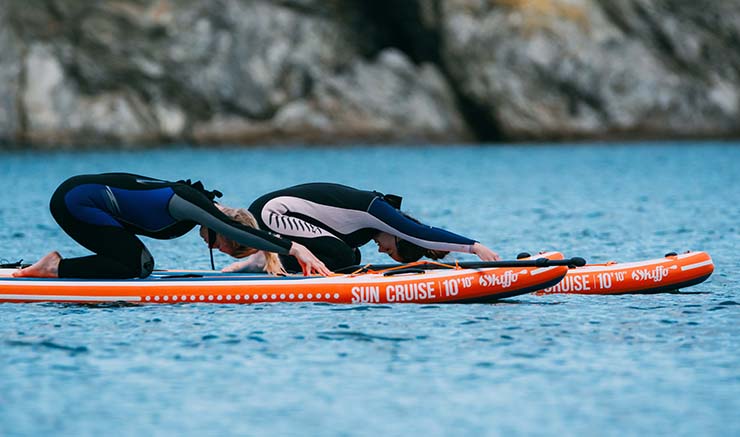
From your tabletop, you can move to a paddle board child’s pose. Make sure that you’re still directly over the center of the board, so you don’t lose balance.
Bring your big toes together to touch on the board’s centerline and widen your knees. Slowly push your hips back to your heels, walk your arms out straight in front of you, and rest your forehead on the deck pad and your body on your thighs.
As you breathe deeply, you can gently bring your arms out to the sides of your SUP if you like and feel the cool water. Rest here and become completely in tune with the environment.
4. Downward-Facing Dog – Adho Mukha Svanasana
Start with a tabletop position. Tuck your toes down and carefully push your hips up and back to straighten your legs and plant your feet. Make sure that you focus on the movement of the board and keeping your balance.
Breathe deeply and push your hands and feet down into the paddle board. Try and get your legs completely straight, but if you can’t it’s ok to have a slight bend in your knees or take a small step back. It’s more important to keep your back straight and maintain balance so you don’t get wet. Look back at the tail of your board.
If you like an extra challenge, you can lift one leg slowly straight up behind you to make a SUP yoga one-legged downward dog. This is a great pose to challenge yourself with once you’ve mastered the regular down dog pose.
5. Plank Yoga Pose – Phalakasana
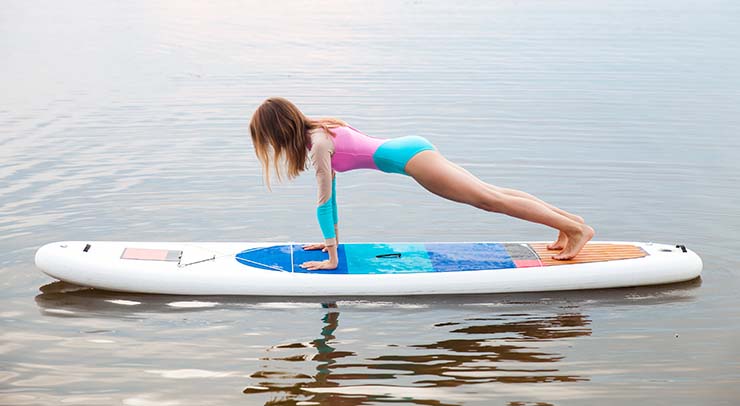
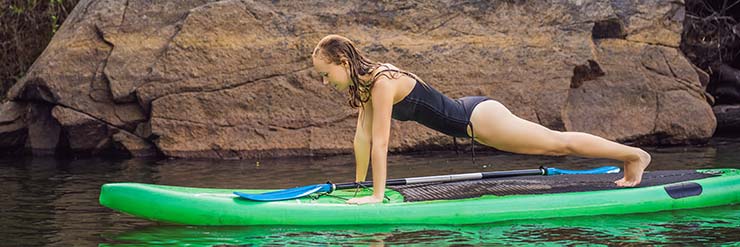
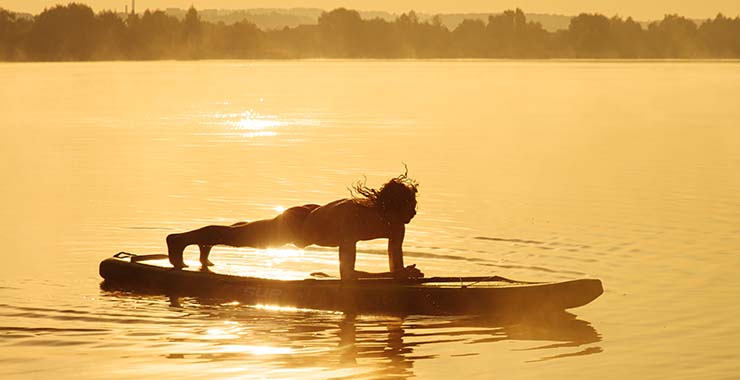
The plank is excellent for your core strength, many people aim to master it on their paddle board. After all, who doesn’t want better abs, particularly when you’re out paddling on a hot day?
From your tabletop position, carefully walk back and straighten your legs behind you. Keep just your toes in contact with the deck.
Keep your back completely straight and your hands directly below your shoulders. Push downwards into the paddle board with your hands and toes. Tighten your core, keep your gaze down.
While you want to hold the position as long as possible, try not to get to the point when you need to collapse. That will likely lead to an unwanted swim. When you feel the end coming, slowly lower your knees down to the deck and recover.
You can make your paddle board plank with straight arms or with your forearms down on the deck to work your upper body as well as your core.
6. Upward-Facing Dog – Urdhva Mukha Svanasana
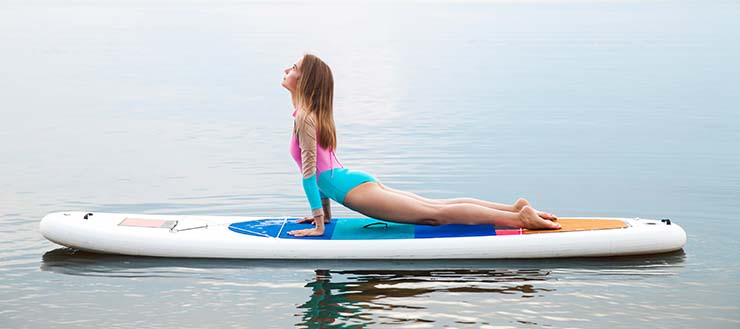
Upward-facing dog is a fantastic stand up paddle board yoga pose that you’ll feel in your shoulders, upper and lower back abs, and legs.
You can start from a plank yoga position and walk your hands back carefully until they’re below your ribs. Push down into the board and lift your torso vertically and arch your back. Keep your legs straight and knees lifted off the paddle board.
Concentrate on getting length in your back and lift your head as high up as possible while looking forward to the horizon. Keep your abs engaged and breathe deeply.
Your hands should be in a straight line directly below your shoulders once you’ve lifted up. Keep lifting your hips up while you push down into the deck through the tops of your feet.
7. Cobra Pose – Bhujangasana
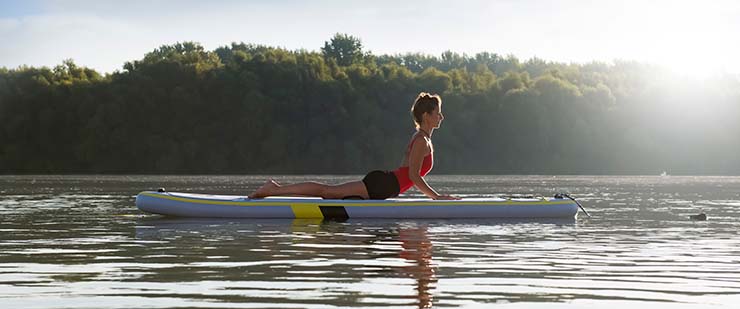
Cobra pose shares many similarities with the upward-dog yoga pose. It’s easiest to start your cobra lying flat, face down on the board. This is one pose where it’s a good idea to feel the water movement before you begin.
Place your hands flat under your shoulders with your elbows tight into your body. Inhale and push down while lifting your head, shoulders, and chest. Unlike the upward dog, your legs and pelvis will stay flat on the board.
As you push upwards and bend your back, your hands will be somewhat in front of your shoulders. Unlike the upward dog, most people will keep some bend at the elbows unless they are remarkably flexible.
Lift your head high, gaze straight ahead towards the horizon, breathe and enjoy the view.
8. Half Camel and Full Camel – Ardha Ustrasana and Ustrasana
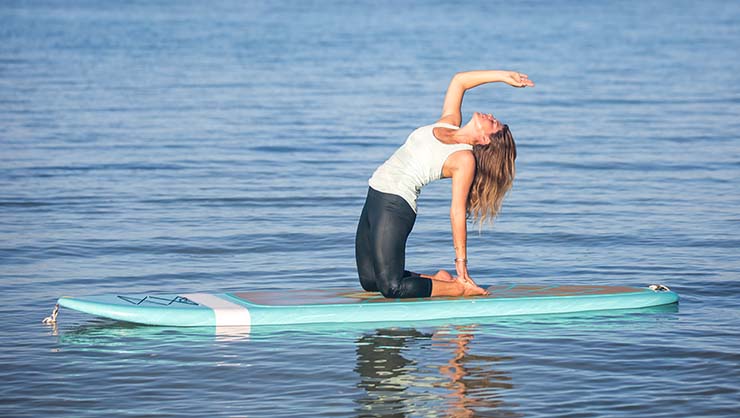
The camel and half camel pose are a backbend that takes us up off our hands. Make sure you go slowly and focus on your balance.
Kneel on your board with your toes tucked. Set your knees on either side of the center handle at about hip-width. Your thighs and back should be vertical. Place your hands on your lower back and slowly start to lean backward.
For the full camel, as you bend, reach both hands to your heels. However, it can be easier at first to make a variation of a half camel on the paddle board. Keep one hand on your lower back while sweeping the other up over your head. Take a few deep breaths in and out, enjoy looking up at the sky, and return to the starting position before switching sides.
9. Pigeon Yoga Pose – Kapotasana
The sleeping pigeon SUP yoga pose is similar to a child’s pose, except you tuck one leg in while having the other straight back.
From a plank pose, you can step your first leg forward to bring the front of your ankle close to the back of the opposite wrist. Your leg will lie across the board, and you’ll now walk your hands forward and lower your body onto your leg. Rest your head down and breathe.
If you’re not quite flexible enough, don’t worry. A dry bag filled with clothes makes a great bolster to support your open hip as you push forwards and down.
10. Bridge Yoga Pose – Setu Bandhasana
The bridge pose is an excellent SUP yoga pose that stretches your back.
Lie on your back with the very base of your spine over the paddle boards center handle. Bend your knees and set your feet a little greater than hip-width so that your fingertips can just reach your heels.
Lift your hips and push them towards the sky. Tuck your shoulders underneath you and clasp your hands together. Push down through your shoulders, hands, and feet and up through your hips.
Take some deep breaths, and then slowly lower yourself back to the board.
If you’re feeling brave, you can develop your bridge into a full wheel pose. Start in the same position but plant your hands by your ears. As you push your hips up, try and straighten your arms to make the bridge. Relax and look back at the horizon.
Standing SUP Yoga Poses
Standing yoga poses are where things on a paddle board get a lot harder. Your center of gravity is higher, and you only have two points of contact. So, make sure that you focus, move slowly, and really try and feel the paddle board underneath you.
11. Crescent Lunge – Anjaneyasana
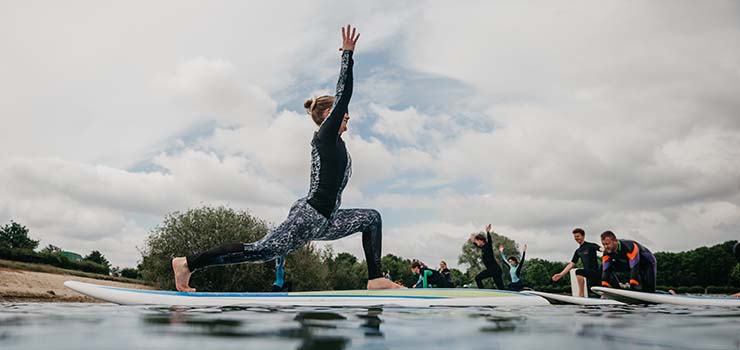
From a downward dog pose, you will step your right foot forward between your hands. Lower your left knee to the deck to make the balance easier. Focus on placing your feet equally on either side of the board’s centerline.
Slowly raise both your arms vertically and stretch up with your back straight. Keep your core tight, and push into the lunge. Take a few breaths and then carefully lower your arms down. Repeat with your left foot forward.
To make a more significant challenge, keep your knee up off the deck pad.
12. SUP Yoga Chair Pose – Utkatasana
The chair pose will strengthen your core and thigh muscles and build balance and control in your feet.
You’ll start with your feet on either side of the center handle. Ideally, you should make the chair pose with your feet together. However, this can be hard, so keep your feet as far apart as needed but no further than hip-width.
Strength your arms out in front horizontally and start to sit back into an imaginary chair. Lower your hips and hinge, as you bend your knees. Keep so you can see your toes, so your knees aren’t covering them.
Make sure your knees aren’t bowing in or out, and keep your toes firmly on the deck. Our challenge is to hold the position for 60 seconds.
You can hold your paddle out in front of you. This adds balance and also gives your arms some work. When you’re settled in the pose, lift your arms vertically and hold the paddle above your head as you sit further.
13. Warrior Poses – Virabhadrasana
Warrior One
Things are getting tricky now, so really pay attention to your movements and balance.
Begin in downward dog. Step your right foot forward between your hands as if you were making a lunge. Position the foot right against the inside of your right hand.
Adjust your left foot, so it is flat on the deck at nearly 90 degrees. Then carefully lift your body and arms straight to the sun. Keep your right knee bent and your left leg straight back.
Look towards the horizon, hold the position and breathe as you focus on your balance. If you find it difficult, you can hold your arms out at your sides as you stand tall.
Warrior Two
The warrior two SUP yoga pose starts in the same way as warrior one. However, you will hold your front arm (the same side as the forward foot) out in front of you horizontally and your back arm behind with your palms down. Keep your head looking forward.
The balance on both these moves can be tricky to begin with, so it can be a good idea to start with your back leg down on the board’s deck. You can trail your foot over the side to make things more comfortable.
14. SUP Yoga Tree Pose – Vrikshasana
This standing pose will really test your balance on the paddle board. Start in a mountain pose with your feet about hip-width apart. Keep your arms by your sides and stand tall with your shoulders relaxed as you feel the board beneath you.
Shuffle slightly, so you center your weight onto the foot you’ll be standing on. Lift your arms out at your sides for balance and lift your right foot a little off the deck. Feel your balance and check that you’re centered before going further.
Keep lifting your right food, sliding the sole up the inside of your leg until it reaches your knee. Feel your balance and bring your hands together in a prayer position at your heart. Keep your head up and look past the nose of your board.
You may find it easier to use your paddle to balance you. You can hold it in both hands across your body and move as needed.
15. SUP Yoga Headstand
The headstand is probably the stand up paddle board yoga pose that everyone wants to be able to do. Indeed, it is the most difficult, and you should master it on dry land before trying it on your board.
Begin in a tabletop and drop your forearms to the deck and clasp your hands together. Lower your head so its top is on the board, and lift your knees to straighten your legs. Walk your toes towards your elbows, and then engage your core muscles and lift one knee at a time to your chest when your back is near vertical.
With both knees up, concentrate on your balance and lift your legs vertically one by one.
16. Boat Pose – Navasana
The SUP yoga boat pose is a seated core strength position that’s often left until last when practicing yoga.
Sit on the center handle with your legs bent at about ninety degrees. Place your hands under your knees and lift your legs off the deck, leaning back a little while keeping your back straight. When your lower legs are parallel with the board, engage your core and stretch your arms out in front.
For the greatest challenge, reach your arms up and straighten your legs out as you hold the boat.
17. Corpse Pose – Savasana
Finally, we can rest and recover from our SUP yoga – and the somewhat morbidly named corpse pose is the perfect pose to do just that.
Lie flat on your back with your feet apart and your arms at your sides. Breathe and embrace the natural environment all around you. Gain contact with the water if the temperature is right and gently dangle your legs and arms overboard – but only if you feel comfortable to do so.
YOU MAY ALSO LIKE: What SUP Yoga Clothing Should You Wear?
Conclusion
I hope you’ve enjoyed my list and that you will try some of these stand up paddle board yoga poses for yourself. If you love yoga, you’ll definitely enjoy a SUP yoga experience on the water!
Remember, you don’t need to master all of the poses immediately. Start slowly, and you’ll quickly be enjoying this exciting new dimension to your paddle boarding.
Let me know what you think in the comments section. What is your favorite SUP yoga pose? Did I miss any that you particularly enjoy?
Are you looking for a new yoga paddle board? Then check out our best yoga paddle boards feature.
If you found this list useful, please share it with anyone you think would be interested. Namaste!

